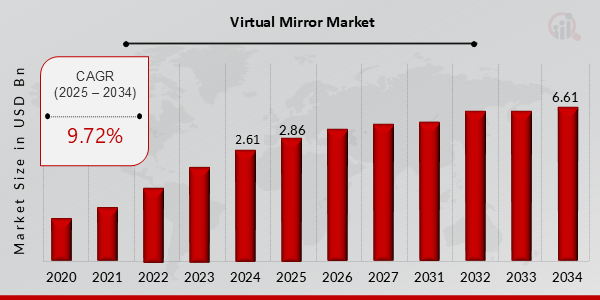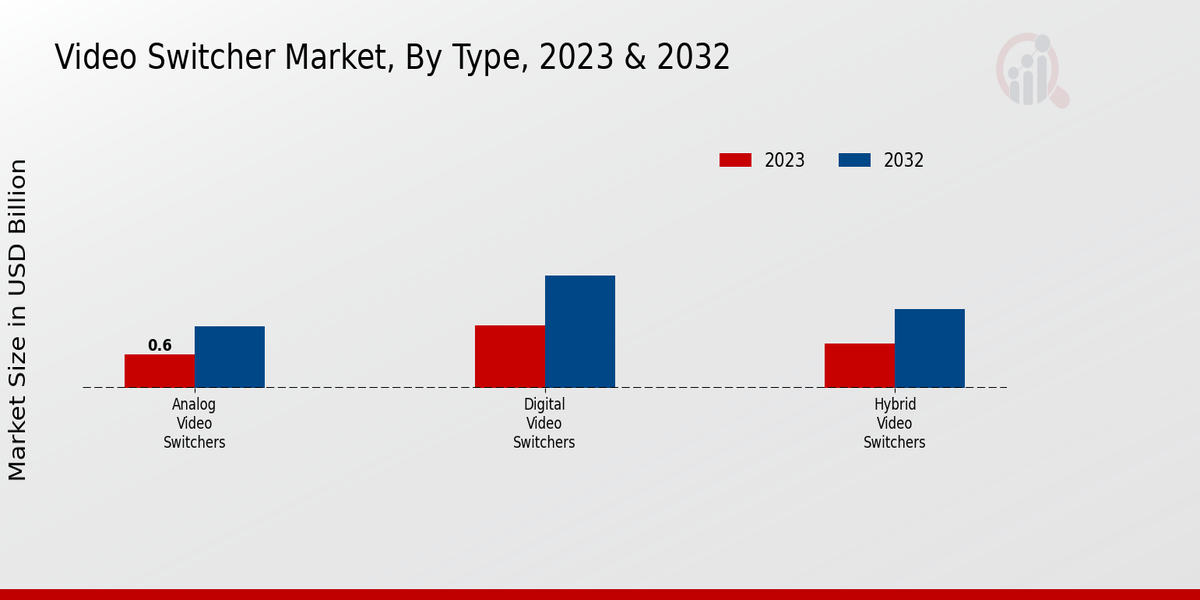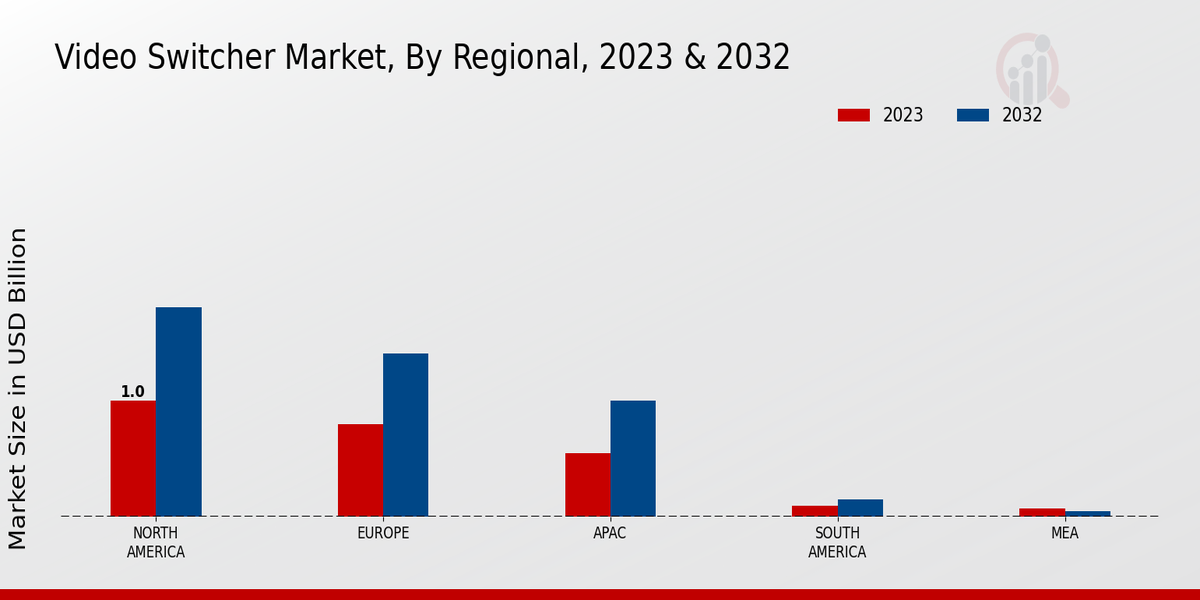Global Virtual Mirror Market Overview
Virtual Mirror Market Size was estimated at 2.61 (USD Billion) in 2024. The Virtual Mirror Market Industry is expected to grow from 2.86 (USD Billion) in 2025 to 6.61 (USD Billion) till 2034, exhibiting a compound annual growth rate (CAGR) of 9.72% during the forecast period (2025 - 2034).
Key Virtual Mirror Market Trends Highlighted
The Virtual Mirror Market is significantly driven by the increasing demand for augmented reality solutions in the retail, fashion, and beauty industries. As consumers seek personalized experiences, virtual mirrors allow for virtual try-ons, enhancing shopping engagement.
The rise of e-commerce has also accelerated the adoption of these technologies, as businesses aim to reduce return rates and improve customer satisfaction.
Moreover, advancements in machine learning and computer vision have improved the accuracy and realism of virtual mirrors, making them more appealing to both consumers and businesses. There are numerous opportunities to be explored within the virtual mirror market.
Retailers can leverage this technology to create immersive shopping experiences that encourage consumers to experiment with products in a virtual space. There is potential for integration with social media platforms, allowing users to share their looks instantly and drive engagement.
Additionally, the application of virtual mirrors in fitness and health for personalized training and wellness advice is an emerging area with growth prospects. Recent trends indicate a shift towards multifunctional virtual mirrors that not only allow for try-ons but also offer additional capabilities like skincare analysis and interactive stylist consultations.
Expansion into emerging markets presents another growth avenue, as increased internet connectivity and smartphone penetration lead to a rise in tech adoption.
Furthermore, collaborations among technology providers, fashion brands, and retailers are on the rise, indicating a trend toward creating unique and interactive brand experiences that cater to the evolving consumer landscape. As these trends continue to grow, the virtual mirror market stands poised for further innovation and expansion.

Source: Primary Research, Secondary Research, MRFR Database and Analyst Review
Virtual Mirror Market Drivers
Growing Demand for Interactive Technology in Retail
The increasing demand for interactive technology in the retail sector is a significant driver for the Virtual Mirror Market. As consumers seek more engaging and personalized shopping experiences, retailers are turning to virtual mirrors to enhance customer interaction.
Virtual mirrors allow customers to try on clothes and accessories virtually, providing a fun and efficient way to shop without the hassle of changing rooms. This technology not only reduces wait times but also increases customer satisfaction, encouraging sales.
Retailers benefit as well since these mirrors can gather valuable data on customer preferences and behavior, enabling them to tailor their offerings accordingly. The trend of digitization in retail is poised to fuel the adoption of virtual mirror technology as businesses strive to create unique experiences that differentiate them in a competitive marketplace.
Furthermore, as augmented reality (AR) becomes more prevalent, the capabilities of virtual mirrors will be enhanced, making them an essential tool in modern retail operations.
As the Virtual Mirror Market continues to expand, companies that leverage this technology will likely gain a considerable edge over competitors, positioning themselves for sustained growth as consumer preferences continue to evolve.
Rapid Technological Advancements
Rapid advancements in technology, particularly in augmented and virtual reality, are driving the growth of the Virtual Mirror Market. Innovations in software and hardware create more realistic and seamless experiences for users.
The improved accuracy of facial recognition and body tracking technologies enhances how virtual mirrors operate, allowing them to render life-like images and provide users with a better understanding of how products would look on them.
These technological improvements are attracting investments in this market as companies realize the potential for differentiated customer experiences. By utilizing sophisticated algorithms and artificial intelligence, virtual mirrors can now offer personalized recommendations, further driving customer engagement and ultimately lead to increased sales.
The continuous progression in technology ensures that virtual mirrors remain at the forefront of retail innovation, making them an appealing choice for businesses looking to modernize and enhance customer experience.
Increase in Online Shopping Trends
The rise in online shopping trends has significantly contributed to the growth of the Virtual Mirror Market. As more consumers turn to e-commerce platforms for convenience, virtual mirrors provide an essential solution for bridging the gap between the physical and digital shopping experience.
They enable online shoppers to visualize how clothing items or accessories would look on them before making a purchase, reducing the uncertainty that often comes with online shopping. This feature helps to minimize return rates, which is a major concern for e-commerce retailers.
The integration of virtual mirrors into mobile apps and websites allows brands to offer an interactive shopping experience, thereby increasing customer engagement and trust. As the e-commerce market continues to expand, the demand for virtual mirrors that enhance online shopping experiences is expected to grow proportionately.
Virtual Mirror Market Segment Insights:
Virtual Mirror Market Technology Insights
The Virtual Mirror Market, primarily driven by advancements in Technology, has gained substantial traction in recent years, positioning itself as a significant player within various industries, including retail, fashion, and healthcare.
Among the various technological innovations, Augmented Reality held a prominent position with a valuation of 0.7 USD billion in 2023 and is projected to rise to 1.5 USD billion in 2032. This segment proves to be crucial as it offers users interactive experiences, allowing them to visualize products in real time, thus significantly enhancing consumer engagement and satisfaction.
Virtual Reality also played a pivotal role, marked by a valuation of 0.5 USD billion in 2023 and an increase to 1.2 USD billion by 2032. The immersive experience that Virtual Reality provides has made it a favorite in venues for training, gaming, and product demonstrations, indicating its expanding applications across varied fields.
Moreover, Artificial Intelligence was emerging as a powerful tool within the Virtual Mirror Market, with a value of 0.4 USD billion in 2023, projected to grow to 1.0 USD billion by 2032. AI enhances personalized recommendations and customer interactions, making it a key driver for market growth, as it improves user experience through tailored solutions.
Computer Vision, rated at 0.57 USD billion in 2023, is anticipated to rise to 1.3 USD billion by 2032, reflecting its significant role in analyzing and interpreting visual data. This segment is essential in enabling the virtual mirror technology to understand user inputs more effectively, providing a seamless and intuitive experience.
The majority holding in the Virtual Mirror Market segmentation highlights the increasing demand for these technologies, driven by factors such as the need for enhanced customer engagement, greater personalization, and the integration of advanced analytics.
Market trends indicate a growing inclination towards these technologies, reflecting an evolving landscape where immersive and interactive experiences are becoming essential for businesses looking to differentiate themselves.
Growth drivers in this market include rapid technological advancements and the increasing investment by enterprises in virtual and augmented solutions. However, challenges such as high implementation costs and the necessity for ongoing updates and training may affect growth rates.
Overall, the Virtual Mirror Market statistics depict a landscape marked by significant opportunities, particularly in the domains of Augmented Reality and Virtual Reality, showcasing the transformative power of Technology in enhancing consumer experiences across various industries.

Source: Primary Research, Secondary Research, MRFR Database and Analyst Review
Virtual Mirror Market Application Insights
The Beauty and Cosmetic sector is particularly influential, enhancing customer experiences through virtual try-ons, which facilitates better purchase decisions, thus driving market growth. The Retail application also plays a critical role, empowering businesses to create immersive shopping experiences, enhancing customer engagement, and promoting increased sales.
Healthcare utilizes virtual mirrors for patient diagnosis and treatment planning, allowing professionals to visualize outcomes more clearly. Automotive applications leverage this technology for vehicle customization and safety features, gaining significant traction in vehicle design processes.
The Virtual Mirror Market statistics reveal that investment in these applications is likely to continue, highlighting the opportunities and advancements shaping the industry. The market growth within these segments will be driven by technological advancements and an increasing focus on digital experiences, ensuring an upward trajectory as we move towards 2032.
Virtual Mirror Market End User Insights
The End User segment of this market encapsulates diverse applications among Individual Consumers, Retail Outlets, Healthcare Institutions, and Automotive Manufacturers. Individual Consumers represent a significant portion, utilizing virtual mirrors for enhanced shopping experiences, offering convenience in trying products virtually.
Retail Outlets leverage this technology to provide customers with an engaging shopping environment, thereby enhancing user experience and increasing sales conversions.
Healthcare Institutions have recognized the potential of virtual mirrors in therapy and rehabilitation processes, facilitating patient interactions and treatments. Automotive Manufacturers are also adopting virtual mirrors for vehicle customization and virtual showrooms, streamlining the buying process.
This diverse application across different industries not only contributes to market growth but also showcases the transformative power of technology in real-world scenarios.
Virtual Mirror Market Deployment Model Insights
The Virtual Mirror Market is witnessing significant growth, especially in the Deployment Model segment, featuring both On-Premises and Cloud-Based implementations. These models cater to varying business needs, with On-Premises solutions providing enhanced data security and control, making them a preferred choice for organizations dealing with sensitive information.
On the other hand, Cloud-Based approaches are gaining traction due to their scalability, cost-effectiveness, and ease of access, making them appealing to companies looking for flexibility and lower upfront costs.
The Virtual Mirror Market data reflects a trend towards increased adoption of Cloud-Based systems, as organizations aim to leverage the advantages of cloud technology in their virtual mirror applications. Overall, this segment is integral to the market's dynamics, showcasing diverse deployment preferences that align with contemporary operational needs.
With Virtual Mirror Market statistics indicating robust growth, understanding these deployment models is crucial for stakeholders aiming to navigate the complexities of the market effectively. As businesses evolve, the demand for tailored solutions in these areas is expected to continue shaping the Virtual Mirror Market's landscape.
Virtual Mirror Market Regional Insights
Among the regions, North America exhibited a majority holding, with a valuation of 0.77 USD billion in 2023, projected to reach 1.78 USD billion by 2032. This dominance is attributed to advanced technology adoption and a strong retail sector driving innovation.
Europe followed, valued at 0.54 USD billion in 2023 and anticipated to reach 1.25 USD billion by 2032, driven by increasing demand for virtual fitting rooms in fashion retail. The APAC region stood at 0.55 USD billion in 2023, with expectations of growing to 1.3 USD billion by 2032, reflecting the rising penetration of online shopping.
In South America, the market was valued at 0.2 USD billion in 2023, expected to grow to 0.45 USD billion by 2032 as digital transformation enhances customer experiences. Meanwhile, the MEA region, valued at 0.11 USD billion in 2023, has significant growth potential, reaching 0.22 USD billion by 2032, as technology adoption increases in various sectors.
As the Virtual Mirror Market evolves, opportunities arise from expanding e-commerce trends and increasing consumer preferences for immersive shopping experiences.

Source: Primary Research, Secondary Research, MRFR Database and Analyst Review
Virtual Mirror Market Key Players and Competitive Insights:
The Virtual Mirror Market has seen significant growth in recent years, driven by technological advancements and consumer demand for interactive digital experiences. As businesses increasingly recognize the potential of virtual mirrors to enhance customer interaction through personalized experiences, competition in this sector has become fierce.
Companies are innovating rapidly to implement augmented reality features that allow users to visualize products such as clothing, cosmetics, and accessories without physical trials. This market is characterized by the emergence of both established players and new entrants, each striving to differentiate themselves through product quality, technology, and user experience.
The ongoing development in artificial intelligence and machine learning is expected to further shape competitive dynamics, making the market a focal point for businesses aiming to capitalize on new revenue streams and consumer preferences. Rokos has established a strong presence within the Virtual Mirror Market, leveraging its innovative technology and user-centric design.
The company's strength lies in its ability to create highly customizable virtual mirror experiences that cater to diverse consumer needs across various retail sectors. Its cutting-edge augmented reality capabilities enhance the shopping experience, allowing users to see themselves with different outfits or makeup options seamlessly.
Rokos is known for its commitment to high-quality graphics and smooth user interactions, ensuring an engaging experience for customers.
Furthermore, the company has formed strategic partnerships with leading fashion and beauty brands, amplifying its reach and enhancing its market influence. Rokos's focus on continuous improvement and adoption of emerging technologies positions it favorably against competitors in the dynamic landscape of the virtual mirror industry.
iMirror is another notable player in the Virtual Mirror Market, recognized for its innovative approaches and robust solutions tailored for retail applications. The company excels in integrating smart technology with user-friendly interfaces to deliver immersive experience for consumers.
iMirror's strength lies in its versatility, as its virtual mirrors are employed in various environments, from clothing stores to salons. The company's emphasis on real-time feedback and interaction transforms the shopping process, allowing customers to experiment with different styles effectively.
Additionally, iMirror is committed to delivering high-quality products that integrate seamlessly into existing retail setups, which enhances their appeal to shop owners looking for integrated solutions.
By consistently investing in research and development, iMirror remains at the forefront of technological advancements in the virtual mirror market, solidifying its competitive stance and catering to the evolving demands of consumers and retailers alike.
Key Companies in the virtual mirror market Include:
Virtual Mirror Market Developments
Recent developments in the Virtual Mirror Market reveal significant advancements and growing interest from major players. Companies like Rokos, iMirror, AR Door, and SmartMirror are increasingly focusing on integrating augmented reality (AR) and artificial intelligence (AI) features to enhance user experience and engagement.
The demand for virtual mirrors in the retail, beauty, and fashion sectors is rapidly rising, with brands seeking innovative solutions for virtual try-ons and personalized shopping experiences. There have been notable mergers and acquisitions, with companies like Vitrue and Holox collaborating to expand their technological capabilities, aiming to bolster their market presence.
In terms of market valuation, entities such as Mirrorshades and Magic Mirror are witnessing impressive growth, driven by increasing investments in AR technologies and the rising adoption of digital solutions across various sectors.
Another company, Everlast, is exploring strategic partnerships to diversify its offerings. The competitive landscape is further energized by ongoing product innovations and enhanced marketing strategies, making it a dynamic and promising market environment.
Virtual Mirror Market Segmentation Insights
-
Virtual Mirror Market Technology Outlook
-
Virtual Mirror Market Application Outlook
-
Virtual Mirror Market End User Outlook
-
Virtual Mirror Market Deployment Model Outlook
-
Virtual Mirror Market Regional Outlook
|
Report Attribute/Metric
|
Details
|
|
Market Size 2024
|
USD 2.61 Billion
|
|
Market Size 2025
|
USD 2.86 Billion
|
|
Market Size 2034
|
USD 6.61 Billion
|
|
Compound Annual Growth Rate (CAGR)
|
9.72% (2025-2034)
|
|
Base Year
|
2024
|
|
Market Forecast Period
|
2025-2034
|
|
Historical Data
|
2020-2023
|
| Market Forecast Units |
USD billion |
| Key Companies Profiled |
Rokos, iMirror, AR Door, SmartMirror, Mirrorshades, Volu, Zyra, Holox, Cubic Mirror, Everlast, Magic Mirror, Vitrue, MIRROR, MirrorMe, Nervotec |
| Segments Covered |
Technology, Application, End User, Deployment Model, Regional |
| Key Market Opportunities |
Increased online retail integration, Rising demand for personalized shopping experiences, Advancements in augmented reality technology, Growth in beauty and fashion sectors, Expansion in e-commerce platforms |
| Key Market Dynamics |
Rising demand for virtual try-ons, Technological advancements in AR/VR, Growth in e-commerce adoption, Increasing fashion industry investment, Enhanced personalization and user experience |
| Countries Covered |
North America, Europe, APAC, South America, MEA |
Frequently Asked Questions (FAQ):
The Virtual Mirror Market is expected to be valued at 6.61 USD billion by the year 2034.
The expected CAGR for the Virtual Mirror Market from 2025 to 2034 is 9.72%.
North America is projected to hold the largest market share in the Virtual Mirror Market, valued at 1.78 USD billion by 2032.
The Augmented Reality segment is expected to be valued at 1.5 USD billion in the Virtual Mirror Market by 2032.
Key players in the Virtual Mirror Market include Rokos, iMirror, AR Door, SmartMirror, and Magic Mirror, among others.
The Artificial Intelligence technology segment is projected to reach a market size of 1.0 USD billion by 2032.
The APAC region is expected to see its Virtual Mirror market size grow to 1.3 USD billion by 2032.
The Computer Vision segment is expected to reach a market size of 1.3 USD billion by the year 2032.
The Virtual Reality segment is anticipated to be valued at 1.2 USD billion in the Virtual Mirror Market by 2032.
Potential challenges to the growth of the Virtual Mirror Market may include technological limitations and the need for high investment in research and development.

















